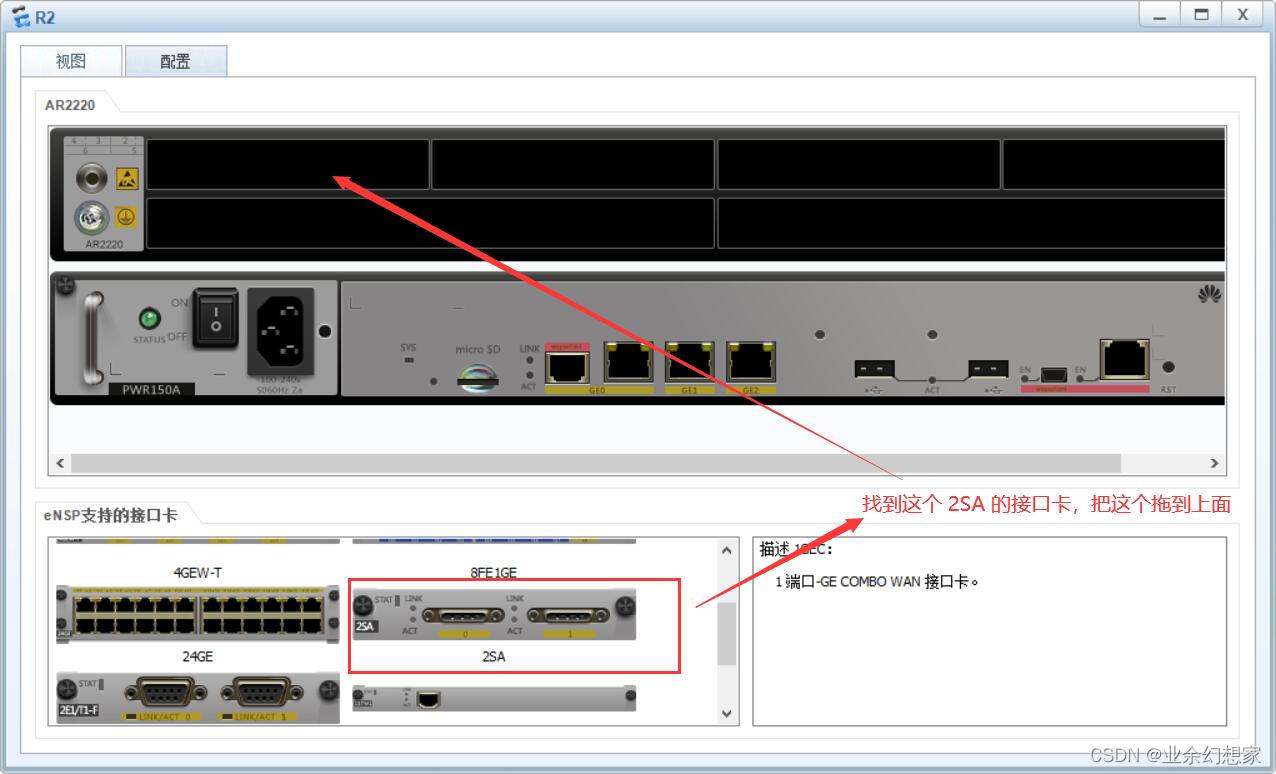PPP 配置实例
PPP(Point-to-Point Protocol)协议是一种点到点链路层协议,主要用于在全双工的同异步链路上进行点到点的数据传输。
文章目录
1、实验目标
通过 PPP 连接两台路由器,同时进行 PAP/CHAP 认证配置
2、网络拓扑图

有些路由器默认是不带 Serial 接口的,但是可以通过手动添加 Serial 接口的硬件来实现,首先选中要添加 Seria l接口的路由器,点击右键,选择设置,进入视图,然后把 2SA 拉取到上面的排孔中,然后就可得到 Serial 接口了
注:添加接口卡只用在设备关闭的情况下才可以进行操作

3、配置步骤
(1)设置路由器端口 IP 地址及链路层协议
R1:
<Huawei>system-view //进入系统视图
[Huawei]sysname R1 //重命名设备
[R1]interface Serial1/0/0
[R1-Serial1/0/0]ip address 10.1.1.1 24 //配置端口 IP 地址
[R1-Serial1/0/0]link-protocol ppp //配置链路层协议为 PPP(该配置为默认配置)
[R1-Serial1/0/0]quit
R2:
<Huawei>system-view //进入系统视图
[Huawei]sysname R2 //重命名设备
[R2]interface Serial1/0/0
[R2-Serial1/0/0]ip address 10.1.1.1 24 //配置端口 IP 地址
[R2-Serial1/0/0]link-protocol ppp //配置链路层协议为 PPP(该配置为默认配置)
[R2-Serial1/0/0]quit
(2)配置认证
PPP 在创建连接时可以有选择的进行认证,将 R1 作为认证方,用户信息保存在本地,要求 R2 对其进行 PAP/CHAP 认证。
在 R1 上创建本地用户及域,并配置端口 PPP 认证为 PAP/CHAP,认证域为 test。
a、配置 R1 作为认证方
R1:
[R1]aaa
[R1-aaa]local-user user1@test password cipher user123 //在本地创建用户 user1@test,并设置密码为 user123,期中 test 为用户所在域名
[R1-aaa]local-user user1@test service-type ppp //配置用户服务类型为 PPP
[R1-aaa]authentication-scheme system-mode //创建一个认证模板 system-mode
[R1-aaa-authen-system-mode]authentication-mode local //在该模板中设置认证时使用本地认证
[R1-aaa-authen-system-mode]quit
[R1-aaa]quit
//如配置端口 PPP 认证方式为 PAP方式,示例如下:
[R1]interface Serial1/0/0
[R1-Serial1/0/0]ppp authentication-mode pap domain test //配置端口 PPP 认证方式为 PAP,并按照 test 域配置进行本地验证
[R1-Serial1/0/0]quit
//如配置端口 PPP 认证方式为 CHAP方式,示例如下:
[R1]interface Serial1/0/0
[R1-Serial1/0/0]ppp authentication-mode chap domain test //配置端口 PPP 认证方式为 CHAP,并按照 test 域配置进行本地验证
[R1-Serial1/0/0]quit
b、配置 R2 作为被认证方
R2:
//如配置端口 PPP 被认证方式为 PAP方式,示例如下:
[R2]interface Serial1/0/0
[R2-Serial1/0/0]ppp pap local-user user1@test password cipher user123 //端口以 PAP 方式被验证
[R2-Serial1/0/0]quit
//如配置端口 PPP 被认证方式为 CHAP方式,示例如下:
[R2]interface Serial1/0/0
[R2-Serial1/0/0]ppp pap local-user user1@test password cipher user123 //端口以 CHAP 方式被认证
[R2-Serial1/0/0]quit
4、测试
(1)在路由器 R1 上查看端口配置信息
查看端口 Serial1/0/0 的配置信息,端口的物理层和链路层的状态都是 UP,并且 PPP 的 LCP 和 IPCP 都是 opened 状态,说明链路层的 PPP 协商已经成功完成
[R1]display interface Serial1/0/0 //查看端口 Serial1/0/0 的配置信息
Serial1/0/0 current state : UP //端口物理层为 UP
Line protocol current state : UP //端口链路层为 UP
Last line protocol up time : 2022-07-22 16:35:20 UTC-08:00
Description:HUAWEI, AR Series, Serial1/0/0 Interface
Route Port,The Maximum Transmit Unit is 1500, Hold timer is 10(sec)
Internet Address is 10.1.1.1/24
Link layer protocol is PPP
LCP opened, IPCP opened //LCP 和 IPCP 都是 opened 状态
Last physical up time : 2022-07-22 16:33:15 UTC-08:00
Last physical down time : 2022-07-22 16:33:10 UTC-08:00
Current system time: 2022-07-22 16:42:14-08:00
Physical layer is synchronous, Virtualbaudrate is 64000 bps
Interface is DTE, Cable type is V11, Clock mode is TC
Last 300 seconds input rate 6 bytes/sec 48 bits/sec 0 packets/sec
Last 300 seconds output rate 2 bytes/sec 16 bits/sec 0 packets/sec
Input: 113 packets, 3634 bytes
Broadcast: 0, Multicast: 0
Errors: 0, Runts: 0
Giants: 0, CRC: 0
Alignments: 0, Overruns: 0
Dribbles: 0, Aborts: 0
No Buffers: 0, Frame Error: 0
Output: 112 packets, 1364 bytes
Total Error: 0, Overruns: 0
Collisions: 0, Deferred: 0
Input bandwidth utilization : 0%
Output bandwidth utilization : 0%
(2)在 R1 上可以 ping 通 R2 的端口 IP 地址,说明链路层 PPP 正常
[R1]ping 10.1.1.2
PING 10.1.1.2: 56 data bytes, press CTRL_C to break
Reply from 10.1.1.2: bytes=56 Sequence=1 ttl=255 time=50 ms
Reply from 10.1.1.2: bytes=56 Sequence=2 ttl=255 time=20 ms
Reply from 10.1.1.2: bytes=56 Sequence=3 ttl=255 time=30 ms
Reply from 10.1.1.2: bytes=56 Sequence=4 ttl=255 time=30 ms
Reply from 10.1.1.2: bytes=56 Sequence=5 ttl=255 time=20 ms
--- 10.1.1.2 ping statistics ---
5 packet(s) transmitted
5 packet(s) received
0.00% packet loss
round-trip min/avg/max = 20/30/50 ms
5、小结
PPP 的认证方式:
- 口令认证协议(PAP):PAP 是一种通过两次握手完成对等实体间相互信息确认的方法。只能在链路刚建立时使用,在链路存在期间不能重复使用 PAP 进行对等实体间的身份确认。
- 挑战握手认证协议(CHAP):CHAP 是一钟通过 3 次握手周期性验证对方身份的方法。在数据链路刚建立时使用,在整个数据链路存在期间可以重复使用。
PPP 协议有如下优点:
- 对物理层而言,PPP 既支持同步链路又支持异步链路,SLIP 仅支持异步链路。
- PPP 协议具有良好的扩展性,例如,当需要在以太网链路上承载 PPP 协议时,PPP 可以扩展为 PPPoE。
- 提供 LCP(Link Control Protocol)协议,用于各种链路层参数的协商。
- 提供各种 NCP(Network Control Protocol)协议(如 IPCP、IPXCP),用于各网络层参数的协商,更好地支持了网络层协议。
- 提供认证协议 CHAP(Challenge-Handshake Authentication Protocol)、PAP(Password Authentication Protocol),更好的保证了网络的安全性。
- 无重传机制,网络开销小,速度快。
文章如有错误之处,欢迎各位大佬批评指正